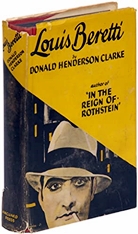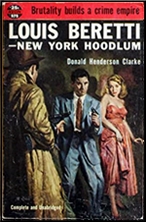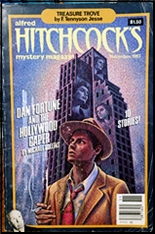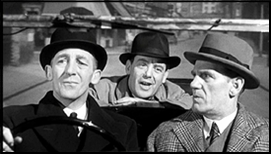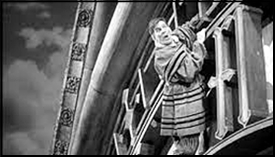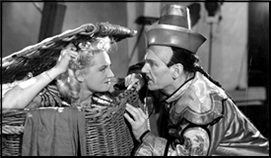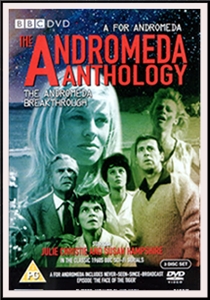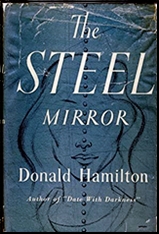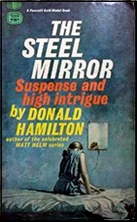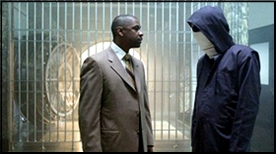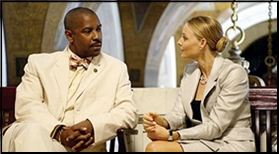REVIEWED BY DAVID VINEYARD:
â— A FOR ANDROMEDA. (1961) Television Serial in six parts. Peter Halliday, Julie Christie, Frank Windsor, John Hollis, Patricia Kneale, Mary Morris. Teleplay by (Sir) Fred Hoyle and John Elliott. Directed by Michael Hayes and others
â— ANDROMEDA BREAKTHROUGH. (1962) Television Serial in six parts. Peter Halliday, Susan Hampshire, John Hollis, Mary Morris, David Saire, Claude Ferrell. Various Directors including John Elliott.
â— A FOR ANDROMEDA. (2006) Tom Hardy, Charlie Cox, Kelly Reilly. Screenplay by Richard Fell, based on the teleplay by Fred Hoyle and John Elliott. Directed by John Strickland.
â— Novelized as A for Andromeda (1962) by Fred Hoyle and John Elliott, and Andromeda Breakthrough (1964) by Fred Hoyle and John Elliott.
The British throughout the fifties and sixties did a series of Science Fiction serials for BBC Television varying from those aimed at younger audiences like City Beneath the Sea and Secret Beneath the Sea, to more adult stories by the legendary Nigel Kneale (Quatermass, The Quatermass Experiment, Quatermass and the Pit, The Trollenberg Terror, The Broken, The Stone Tapes) whose work was often made into feature films, as well as other creators’ works such as Doomwatch, and the John Wyndam remake of Day of the Triffids, and the Tripods.
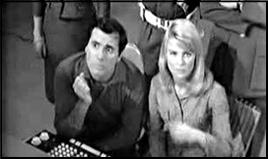
At a time when most American SF was limited to anthology series like The Twilight Zone and The Outer Limits or children’s fare the British were doing intriguing SF with grown up themes, and of course a fair amount of monsters.
A for Andromeda, created by BBC producer and creator John Elliot and Plumian Professor and Science Fiction author Sir Fred Hoyle in 1961, is one of the more legendary of these serials if only because of the young actress introduced as its title character, Julie Christie.
The story is simple enough. In 1970 John Fleming (Peter Halliday) and his friend Brenner (Frank Windsor) are working at a civilian facility on a radio satellite designed to aid the military in intercepting radio traffic by potential enemies. To that end Fleming is scanning deep space as he fine tunes the satellite, a rebel pursuing his own interests at the governments expense.
The arrival of a Judy Adamson (Patrica Kneale) a new security expert sent in as a public relations expert comes at an inopportune time for Brenner who has secretly been selling information to Intel a mysterious multi national group run by the mysterious Krautman (John Hollis).
Everything changes when the computers detect a signal coming from space, from the Andromeda region, and when Fleming begins to decipher the code suddenly the military’s interception of radio traffic isn’t half as important.
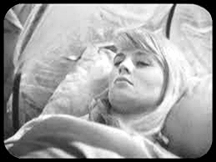
The coded transmission proves to be binary code for a super computer and the team is moved to a remote base in the Hebrides to build it, as Brenner is pressured by Krautman and his threatening chauffeur Egon (Paul Henchie)who even takes a few pot shots with a high powered rifle to scare Adamson off.
When the computer transmits information for the creation of a biological entity Professor Dawnay (Mary Morris) is brought in and Fleming begins to question the safety of the project. Just what are the motives of the high handed alien intelligence behind the computer? Are they all being led down a rabbit hole by a malign alien intelligence?
When Catherine (Julie Christie with dark hair) Brenner’s assistant is killed in an accident by the computer it creates a new biological avatar in her image, Andromeda, aka Andre (Julie Christie now an ethereal blonde) and destroys the “Cyclops†the previous attempt made by Dawnay.
Meanwhile Adamson has closed in on Brenner and Krautman is pressuring Fleming as the latter becomes more and more convinced the computer is controlling Dawnay and the others around it as much as it does Andre, and when it attempts to kill Dawnay with a flesh eating bacteria when she questions it Fleming sees the only chance as appealing to Andre’s human side since the Prime Minister and the military can only see the super computer as a way to rebuild Britain’s lost glories.
The Intel sub-plot is seemingly sidelined at this point, but comes back with a vengeance in Andromeda Breakthrough. The first serial stands alone, but is enhanced by the second.
In the end Fleming succeeds in appealing to Andre’s human side and is able to destroy the computer while Andre destroys the instructions for building a new machine after realizing the computer will ultimately destroy her. Andre and Fleming escape pursued by the Royal Marines in charge of security to a nearby cave where Andre seemingly drowns in a pool and Fleming is arrested, but the world is safe.
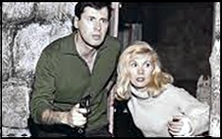
Andromeda Breakthrough picks up exactly where the first serial ended with Fleming under arrest and Andre (now played by yet another major discovery, Susan Hampshire of The First Churchills and Fleur in The Forsyte Family) supposedly dead. She isn’t though and soon, with Fleming, she is under arrest.
That changes when Fleming, Andre, and Dawnay are kidnapped by Intel and Krautman and Mlle Gamboule (Claude Ferrell) and flown to the Arab kingdom of Azaran where Intel has rebuilt the super computer and needs their expertise.
In the meantime Andre’s health begins to fail and Fleming and Dawnay rush to save her as the world’s weather begins to deteriorate and Andre traces it to an alien enzyme that threatens to destroy Earth’s fragile climate.
With the new computer exerting influence on Mlle Gamboule and amid murderous storms and a revolution in Azaran Fleming, Dawnay, and Andre must fight to save the world and Andre and finally solve the puzzle of the mysterious alien message that began the whole thing while divining the secret of Andre’s creation.
Both serials begin fairly slowly, but build up exponentially as they go on with more plot threads and character arcs than I can cover here, as you might expect of the serial form. Both deal with elements of the outside worlds reaction to these events that I’ve largely ignored here.

A for Andromeda is, sadly, lost. It has been recreated using what footage still exists and titled stills from the series into a two hour feature that covers the story fairly well, and luckily most of the last two episodes are intact including the exciting ending. It was remade as a movie in 2006 starring Tom Hardy as Fleming, though unfortunately much of the plot is sacrificed and a different ending tacked on that does not allow for the events of Andromeda Breakthrough. It’s not bad, but truncating a six part serial into a less than ninety minute movie means a lot of vital story is lost for what becomes a basic Frankenstein story.
The restructured original serial, the 2006 remake, and the entire six episode Andromeda Breakthrough serial are currently available on YouTube in decent prints, and while time has blunted some of the originals scientific edge both serials remain worth seeing.
Most seem to agree the brunt of the writing on both the serial and the two novelizations was done by John Elliott with Fred Hoyle, despite being the author of such Science Fiction classics as Ossian’s Ride, October the First is Too Late, and The Black Cloud, is largely a technical adviser. Still considering Fred Hoyle is the man who coined the phrase “the Big Bang†(however sardonically) and whose Steady State Theory of the Universe has recently been back in favor (as flawed but useful) among many physicists attempting to understand the nature of the Universe that’s a pretty good technical adviser for any SF series.
I read the two novels years before ever seeing the serial and still hold them in high regard as excellent SF thrillers of a kind of near future SF the British seemed to specialize in (John Wyndham, Charles Eric Maine, Christopher Hodder-Williams, Archie Roy, John Christoper, L. P. Davies etc.). Both held up well on rereading, though now I can’t help but see the characters in relation to the actors who played them. The books, published here in paperback by Fawcett Crest in 1967 when I was seventeen, were fairly seminal in my adult Science Fiction reading and expand on the serials rather than just aping them.
In any case, that the two serials provided the screen with both Julie Christie and Susan Hampshire is a fairly good reason in and of itself to check them out.
